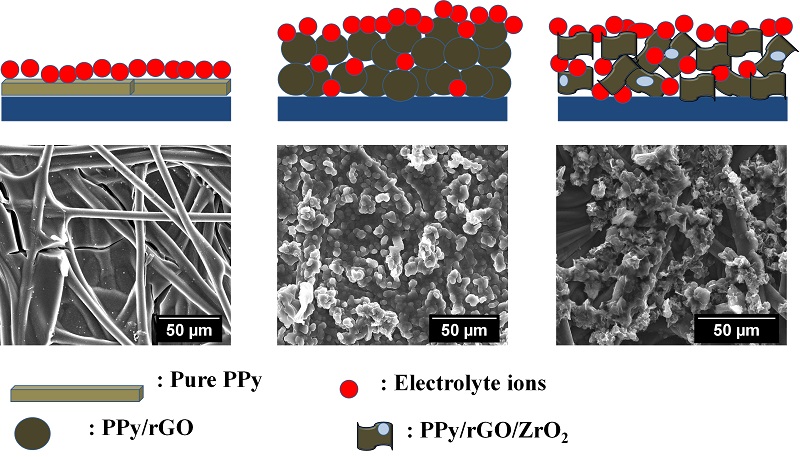[Paper: One-step electrodeposited 3D-ternary composite of zirconia nanoparticles, rGO and polypyrrole with enhanced supercapacitor performance. Alves, Ana Paula P.; Koizumi, Ryota; Samanta, Atanu; Machado, Leonardo D.; Singh, Abhisek K.; Galvao, Douglas S.; Silva, Glaura G.; Tiwary, Chandra S.; Ajayan, Pulickel M. NANO ENERGY, volume 31, January 2017, 225–232. DOI: 10.1016/j.nanoen.2016.11.018.]
Advanced material for ultra-capacity supercapacitors.
Supercapacitors are electrical storage devices with a particular feature of releasing large amounts of energy in a short time interval. They are already used, for example, in electric or hybrid vehicles, camera flashes and elevators, but they can still be improved – largely with the contribution of Materials Science and Technology – for current and potential applications. Putting it simply, a supercapacitor consists of two electrodes, positive and negative, separated by a substance containing positive and negative ions (the electrolyte).
An article recently published in the scientific journal Nano Energy (Impact Factor 11,553) reports on a contribution from an international and interdisciplinary scientific team to develop materials that improve the performance of supercapacitors. Using a simple and easily scalable process, the team of researchers from Brazil, the United States and India produced electrodes made of a composite material composed of polypyrrole (PPi), reduced graphene oxide (rGO) and zirconium oxide (ZrO2) nanoparticles. By combining the three materials, the scientists were able to generate a large surface area and high porosity electrode – basic characteristics to promote the interaction of the electrolyte ions with the surface of the electrodes and therefore enhance the performance of the supercapacitor.
“Our unique contribution was the synthesis, in a single and simple stage of electrodeposition, of a hybrid containing graphene, zirconium oxide and polypyrrole, and the experimental demonstration of considerable gains in electrochemical properties, parallel to the theoretical modeling in order to understand the role of the components of the material”, states Glaura Goulart Silva, professor in the Department of Chemistry at the Federal University of Minas Gerais (UFMG) and a corresponding author of the paper.
In addition to preparing samples of the ternary (i.e., composed of three elements) composite PPi/rGO/ZrO2, using the same method for comparison purposes, the team prepared samples of the PPi/rGO binary composite, and pure polypyrrole samples. The three materials were analyzed using XPS (spectroscopy of X-ray excited photoelectrons), SEM (Scanning Electron Microscopy), Raman spectroscopy and transmission electron microscopy to determine their composition, structure and morphology.
As seen in the SEM images of the figure below, the scientists noted that the addition of graphene oxide and zirconia nanoparticles significantly changed the morphology of the material. While the pure polypyrrole had formed a cracked, wire-like film, the graphene composite had a granular morphology, with no cracks, and the zirconium oxide material had a leaf-like appearance.
At the end of the experimental stage of the study, the scientists performed a series of tests to measure the performance of the three materials as supercapacitors. The results showed that the capacity to store electrical charges (capacitance) had increased up to 100% in the ternary composite with respect to the polypyrrole. Moreover, instead of decreasing this performance due to the use of the electrode, it increased by 5% after 1,000 recharges in the binary and ternary composites.
This was the first paper that presented the introduction of zirconium oxide nanoparticles in polypyrrole and graphene electrodes for supercapacitors. Therefore, the team performed computational modeling to analyze the role of zirconium oxide in the performance of the composite. The simulations confirmed the beneficial effects of the nanoparticles on the stability of the material, directly related to extending the life of the electrodes.

“There is great potential in the application of these new composites in supercapacitors due to the need to increase the energy density provided by the device, in parallel with its miniaturization,”declares Professor Goulart Silva. “The alternative developed in the work in question allows better performance in terms of cycling stability with gains in the safety of the supercapacitor. The use of supercapacitors and batteries in electric and hybrid cars is one of the technological fronts where these materials can be applied,” she adds.

The work is part of the doctorate in Chemistry of Ana Paula Pereira Alves, conducted with the guidance of Professor Goulart Silva and defended in February of this year at UFMG with a thesis about synthesis and characterization of advanced materials for supercapacitors. During her doctoral work at the University of Minas Gerais, Pereira Alves carried out intensive training in synthesis techniques and physical-chemical analysis of conjugated polymers and graphene and in the characterization of supercapacitors. In 2015, she went to the United States for a one-year “sandwich” internship, with the support of the National Council for Scientific and Technological Development (CNPq), in the Department of Materials Science and Nanoengineering at Rice University, in the research group of Professor Pulickel Ajayan (researcher with h=139 index according to Google Scholar), who has collaborated with Professor Goulart Silva’s group since 2010. “Professor Ajayan has systematically proposed radical innovations in synthesis and design of batteries and supercapacitors, with significant international impact in the area,” she adds.
The experimental work reported in the paper was carried out at Rice University, with the presence of all authors, including those from Brazil and India, and also Professor Goulart Silva, who was there in February 2016, with the support of Minas Gerais Research Foundation (Fapemig). “The highly interdisciplinary environment of the Department of Materials Science and NanoEngineering at Rice made possible for the engineers, physicists, and chemists to come together to work on a current major problem.”, says Goulart Silva.
The computational modeling was carried out by Brazilian researchers from the State University of Campinas (Unicamp) and the Federal University of Rio Grande do Norte (UFRN) –among them Professor Douglas Galvão (Unicamp), who has maintained a scientific collaboration with Professor Ajayan since before the beginning of this research.
“I consider this work to be an excellent example of success, where the competence of the Brazilian groups joined that of a highly productive and impactful group in the international scenario and complement each other,” declares Goulart Silva. “The stability and increase of investments in research and development in Brazil are essential for endeavors as this to be widespread. Research is an investment that needs to be done over the long term, without setbacks, to enable a high rate of return in terms of materials, technologies and highly qualified people. Ana Paula Alves is now a young doctor in search of the opportunity to put together her research group and hence train new students and hence contribute to face the challenges of our country,” reaffirms Goulart Silva.
